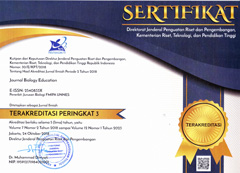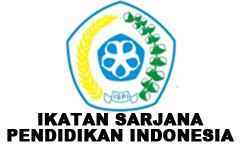PENERAPAN PENDEKATAN PROBLEM POSING DENGAN MODEL PREDICT OBSERVE EXPLAIN (POE) PADA MATERI FOTOSINTESIS DAN GERAK TUMBUHAN
Abstract
Â
_______________________________________________________________
Penelitian ini bertujuan untuk menguji keterterapan dan keefektifan pendekatanproblem posing dengan model predict observe explain (POE) pada materi fotosintesis dan gerak tumbuhan di SMP. Design penelitian yang digunakan yaituPre Experimental Design dengan pola One Shot Case Study yang diterapkan kepada seratus siswa VIIIA, VIIIB, dan VIIIC. Sampel diambil dengan teknikconvenience sampling. Hasil penelitian menunjukkan bahwa rata-rata keaktifan siswa mencapai ≥83% dan ketuntasan klasikal hasil belajar sebesar 82%, kinerja guru termasuk criteria baik (84%), 75% alat dan bahan praktikum tersedia, sebagian besar siswa (≥92%) dan guru Biologi kelas VIII memberikan tanggapan yang positif terhadap pembelajaran. Berdasarkan hasil penelitian disimpulkan bahwa penerapan pendekatan problem posing dengan model predict observe explain (POE) dapat diterapkan dan efektif untuk meningkatkan hasil belajar dan aktivitas siswa pada materi fotosintesis dan gerak tumbuhan di SMP N 3 Lasem.
Abstrak
Â
Abstract
_______________________________________________________________
The aims of this study to test  theappliedand effectiveness of the problem posing approach with predict observe explain (POE) model at the study of photosynthesis and plant movement in junior high school. The study design which was used Pre Experimental Design with One Shot Case Study Design which was applied to one hundred students from grade VIIIA, VIIIB, and VIIIC students. Sampleswere taken by a convenience sampling technique. The research showed that the mean of student’s activeness during the study reach to ≥83 % and students’ mastery learning equal to 82%, the teacher’s performance during the study was good categories (84%), The availability of equipment and material experimentwas75%, most of student (92%) and Biology teacher of grade VIII gave positivelyresponded to lesson. Based on the result of study can be concluded that the implementation of problem posing approach with predict observe explain (POE) model can be applied and effective to improve student learning outcomes and students activity on the material of photosynthesis and plant movement in the SMP N 3 Lasem.
References
Akay H &Boz N. 2010.The effect of problem posing oriented analyses-II course on the attitudes toward mathematics and mathematics self-efficacy of elementary prospective mathematics teachers.Aust J Teach Edu 35(1): 1-75.
Arkoudis S. 2006. Teaching International Students: Strategies to Enhance Learning. Onlineathttp//www.cshe.unimelb.edu.au/resources_teach/teaching_in_practice/docs /international.pdf.[diakses tanggal 28 November 2013].
Chong WL. 2004. The effectiveness of Predict-Observe-Explain technique in diagnosing student’s understanding of science and identifying their level of achievement. Thesis. Australia: Curtin University of Technology.
Dalyono M. 2005. Psikologi Pendidikan. Jakarta: PT Rineka Cipta.
Fenwick TJ. 2001. Using student outcomes to evaluate teaching: A cautious exploration. New Direct Teach Learn 88(4): 63-74.
Lukman M. 2011. Penerapan model pembelajaran PROBEX (predict, observe, explain) dibantu program authoware untuk meningkatkan hasil belajar siswa kelas VIII MTs Al Bidayah pokok bahasan gerak pada tumbuhan tahun pelajaran 2010/2011 (Skripsi). Semarang: Universitas Negeri Semarang.
Masrob M. 2005. Hubungan Antara Latar Belakang Pendidikan dan Masa Kerja dengan Kemampuan Mengajar Guru SMP Negeri di Kecamatan Kisaran Barat Kabupaten Asahan (Thesis). Medan: Universitas Negeri Medan.
Rakes GC, FieldsVS, &CoxKE. 2006. The influence of teachers’ technology use on instructional practices. J Res Tech Edu 38(4): 409-426.
Rifai A & Anni CT. 2012. Psikologi Pendidikan. Semarang: Unnes Press.
Slameto. 2010. Belajar dan Faktor-Faktor yang Mempengaruhinya. Jakarta: Rineka Cipta.
Sigit. 1982. Manajemen Sumber Daya Insan. Jakarta: Gramedia.
Sudjana S. 2002. Metode dan Teknik Pembelajaran Partisipatif. Bandung: Falah Production.
[TIMSS] Trends in International Mathematics and Science Study. 2012. TIMSS 2011 Internasional Results in Science. Online at http://timss.bc.edu/timss2011/international-results-science.html [19 Februari 2013].
The copyright of the article once it is accepted for publication shall be assigned to the journal as the publisher. The intended copyright includes the right to publish the article in various forms (including reprints). The journal maintains the publishing rights to the published articles.
This work is licensed under a Creative Commons Attribution 4.0 International License.







